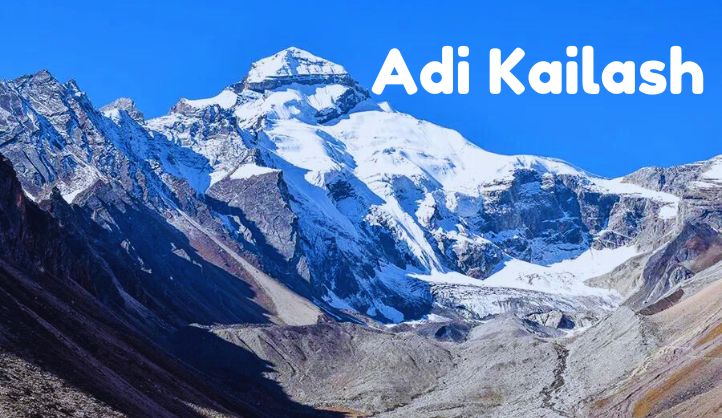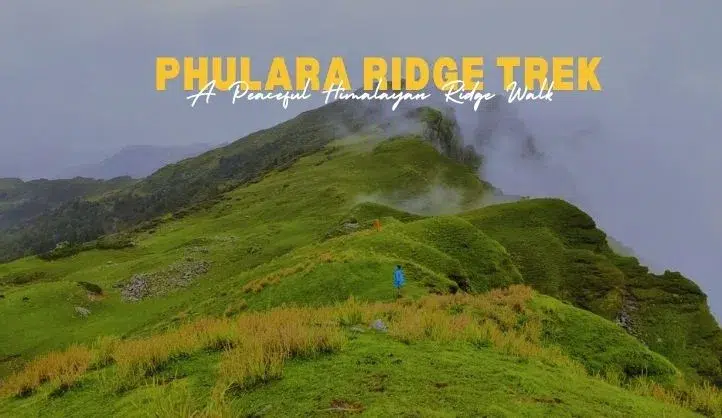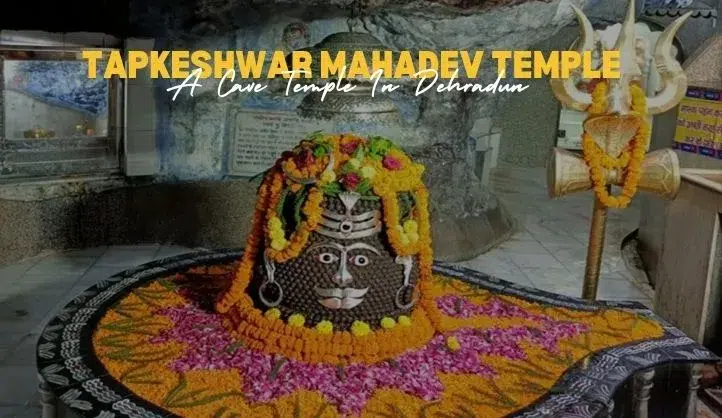Adi Kailash, also known as Chota Kailash or Little Kailash, is a sacred mountain located in the Indian state of Uttarakhand. It is revered by Hindus, Buddhists, and Jains alike, and holds significant religious and spiritual importance.
Location and Geography
Adi Kailash is situated in the eastern part of the Kumaon region of Uttarakhand, near the Indo-Tibetan border. It lies in the lap of the Himalayas, surrounded by stunning natural beauty, dense forests, and high-altitude meadows. The mountain is part of the Greater Himalayan range and stands at an elevation of approximately 6,191 meters (20,312 feet).
History of Adi Kailash
- Religious Significance: Adi Kailash is revered as a sacred mountain similar to Mount Kailash in Tibet, albeit on a smaller scale. It is believed to be the abode of Lord Shiva and Parvati by Hindus and a place of spiritual significance for Jains as well.
- Jain Connection: For Jains, Adi Kailash is associated with their religious beliefs regarding the origin and propagation of Jainism. It is believed to be the spot where Rishabhadeva, the first Tirthankara, attained salvation (moksha).
- Historical Pilgrimage: The area around Adi Kailash has been a pilgrimage site for centuries, attracting devotees and seekers who undertake arduous journeys to pay homage and seek spiritual fulfillment.
- Cultural Heritage: The region surrounding Adi Kailash is steeped in cultural heritage, with local traditions and folklore intertwining with the religious narratives associated with the mountain.
- Trekking and Exploration: In recent decades, Adi Kailash has also become a destination for trekking enthusiasts and nature lovers seeking to explore the rugged beauty of the Himalayas and experience the tranquility of the surrounding landscapes.
- Conservation Efforts: Due to its spiritual and ecological importance, efforts have been made to preserve the natural environment around Adi Kailash, ensuring that future generations can continue to appreciate its beauty and significance
Why Adi Kailash is Famous
Spiritual Significance: Adi Kailash is famous primarily for its deep-rooted spiritual importance. It is regarded as a sacred abode of Lord Shiva and a destination for devout pilgrims seeking blessings and enlightenment.
Mythological Relevance: The mountain’s fame is linked to the epic Mahabharata, where it is believed to be the spot where the Pandavas embarked on their final journey towards salvation. This mythological association adds to its allure.
Unique Parikrama: Adi Kailash is renowned for the ‘Parikrama’ – a circumambulation trek around the mountain. This challenging yet spiritually rewarding trek draws adventure enthusiasts and pilgrims alike from all over the world.
Natural Beauty: The scenic beauty of Adi Kailash is another reason for its fame. Towering peaks, pristine lakes, dense forests, and picturesque landscapes make it a paradise for nature lovers and photographers.
Cultural Encounters: Travelers to Adi Kailash often have the opportunity to interact with the local Bhotia and Tibetan communities, immersing themselves in unique cultures and traditions.
Things to Do in Adi Kailash
- Parikrama Trek: Embark on the challenging Parikrama trek that encircles Adi Kailash, offering breathtaking views of the mountain and surrounding landscapes.
- Visit Om Parvat: Nearby, you can explore Om Parvat, a mountain famous for its naturally occurring ‘Om’ symbol on its surface.
- Seek Blessings: Visit the sacred temples and monasteries in the region, including the Adi Kailash Temple, to seek blessings and immerse yourself in the spiritual ambiance.
- Nature Photography: Capture the mesmerizing beauty of the Himalayas, serene lakes like Parvati Sarovar, and the diverse flora and fauna that inhabit the region.
- Cultural Interaction: Interact with the warm and hospitable Bhotia and Tibetan communities, gaining insights into their lifestyles, art, and traditions.
- Adventure Sports: For the adrenaline junkies, the region offers opportunities for camping, rock climbing, and exploring the rugged terrain.
- Relax and Meditate: Find peace and solace amidst the serene surroundings. Meditate by the lakeside or simply enjoy the tranquility of the mountains.
Adi Kailash Bike Tour
Book your Adi Kailash Bike Tour with Wander Sky. It offers adventurers an exhilarating journey through the rugged terrain of Uttarakhand’s Himalayas. Starting from Kathgodam or Pithoragarh, bikers traverse scenic routes via Dharchula or Munsiyari, soaking in panoramic views of snow-capped peaks and lush valleys. Key stops include Dharchula for permit checks, Gunji for base camp preparations, and Om Parvat for spiritual reflection. The tour culminates at Adi Kailash, where bikers can park and trek to this sacred peak, revered in Hindu and Jain mythology. With expert guides and logistical support, Wander Sky ensures a seamless experience, combining the thrill of biking with the tranquility of the Himalayan landscape and cultural immersion.
Things to Know about Adi Kailash
Sacred Pilgrimage: Adi Kailash, also known as Chhota Kailash, is a revered pilgrimage site for Hindus. It holds significant religious importance, attracting devotees seeking spiritual enlightenment.
Mythological Connections: Adi Kailash is linked to the epic Mahabharata, which it is believed to be the starting point of the Pandavas’ journey towards heaven. It is also considered an abode of Lord Shiva.
Trekking Paradise: Beyond its spiritual significance, Adi Kailash offers a challenging and rewarding trekking experience. The ‘Parikrama’ trek around the mountain is a popular route, known for its rugged terrain and breathtaking vistas.
Natural Beauty: The region is characterized by pristine landscapes, dense forests, alpine meadows, and glacial lakes. Parvati Sarovar, a sacred lake, adds to the area’s natural charm.
Cultural Diversity: Adi Kailash is home to the Bhotia and Tibetan communities, providing an opportunity for cultural interactions and insight into their traditions.
How to Reach
- Travel to Pithoragarh – Start by reaching Pithoragarh, The nearest railhead is Kathgodam, from where you can take a bus or taxi to Pithoragarh.
- Pithoragarh to Dharchula – From Pithoragarh, travel to Dharchula, which is about 90 kilometers away. Dharchula is a small town and a starting point for the journey towards Adi Kailash.
- Dharchula to Tawaghat – From Dharchula, proceed to Tawaghat, which is around 20 kilometers away. Tawaghat serves as a base for further travel towards Gunji.
- Tawaghat to Gunji – From Tawaghat, continue your journey to Gunji, which is approximately 20 kilometers away. Gunji is a crucial point from where trekking to Adi Kailash begins.
- Trek to Adi Kailash – The trek from Gunji to Adi Kailash is a challenging yet rewarding experience. It usually takes about 4-5 days to trek to Adi Kailash, depending on the pace and weather conditions.
- Permission and Guidance – It’s advisable to obtain necessary permissions from local authorities or the Forest Department before undertaking the trek. Additionally, hiring a local guide familiar with the terrain can be beneficial for navigation and safety.
- Preparation – Ensure you are adequately prepared for high-altitude trekking, with appropriate gear, clothing, and provisions. The weather in the Himalayas can be unpredictable, so be prepared for sudden changes.
Travel Tips for Adi Kailash
- Physical Fitness: Before embarking on the Adi Kailash trek, ensure you are in good physical condition. The trek involves steep ascents and challenging terrain, so physical fitness is crucial.
- Acclimatization: Acclimatize properly to the high altitude to prevent altitude sickness. Spend a day or two in a nearby town like Pithoragarh before starting the trek.
- Local Guides: Hire an experienced local guide who is familiar with the trekking routes and the region’s nuances.
- Permits: Obtain the necessary permits from local authorities and the Indian Army, especially if you are a foreign traveler. Ensure you have all the required documents before starting the trek.
- Pack Light: Pack only the essentials and travel light. Carry warm clothing, trekking gear, a first-aid kit, and high-energy snacks. It’s crucial to keep your backpack manageable.
- Water and Hydration: Carry a sufficient supply of clean drinking water or water purification tablets. Staying hydrated is essential at high altitudes.
- Weather Awareness: Dress in layers and carry rainproof and cold-weather gear, even during the summer months.
- Respect Local Customs: When visiting temples and monasteries in the area, dress modestly and respect local customs and traditions. Seek permission before taking photographs in religious sites.
- Campsite Etiquette: If you’re camping during the trek, follow Leave No Trace principles. Leave campsites clean and dispose of waste responsibly.
Best Time to Visit Adi Kailash
Summer (May to June) – This is the most popular time to visit Adi Kailash. The weather is relatively mild, with daytime temperatures ranging from 10°C to 20°C (50°F to 68°F). The trekking trails are accessible, and the views are spectacular.
Early Autumn (September to October) – Another favorable time for trekking, with pleasant daytime temperatures around 15°C to 25°C (59°F to 77°F). The skies are clear, offering excellent visibility of the surrounding mountains.
Monsoon (July to August) – Avoid visiting during the monsoon season due to heavy rainfall, which can lead to landslides and difficult trekking conditions. Trails may be slippery and dangerous.
Winter (November to April) – The winter months are extremely cold, with temperatures dropping well below freezing, making trekking and camping nearly impossible. Adi Kailash is best visited during the warmer seasons.
Places to Eat Near Adi Kailash
- Local Dhabas and Tea Stalls: Along the trekking route to Adi Kailash, you’ll come across small local dhabas (roadside eateries) and tea stalls. These are perfect for a quick meal or a cup of hot tea to rejuvenate during your trek.
- Guesthouses and Homestays: Some guesthouses and homestays in nearby villages like Gunji and Kutti offer meals to trekkers. These meals often include local cuisine, giving you a taste of the region’s flavors.
- Pack Your Own Meals: Due to the remote location of Adi Kailash, it’s advisable to carry some of your own non-perishable food items such as energy bars, nuts, and canned goods to ensure you have sustenance throughout your trek.
- Packed Lunch from Trekking Agencies: If you’ve booked a trekking tour with an agency, they may provide packed lunches for you during the trek. Check with your tour operator for details.
Nearby Places to Visit
Om Parvat
Om Parvat, famous for the naturally occurring ‘Om’ symbol on its surface, is a must-visit destination near Adi Kailash. It holds immense spiritual significance and is accessible on the trekking route.
Parvati Sarovar
Parvati Sarovar is a pristine glacial lake located near Adi Kailash. It’s an ideal spot to unwind and enjoy the natural beauty of the region.
Kailash Mansarovar
While Adi Kailash is often considered the ‘Chhota Kailash’ or ‘Little Kailash,’ the famous Kailash Mansarovar, located in Tibet, is a major pilgrimage site and can be visited by those seeking a more extensive spiritual journey.
Dharchula
This border town near the Indo-Nepal border is picturesque and culturally rich. It offers views of the Kali River and the Dharchula Bridge, along with opportunities to experience local culture and cuisine.
Panchachuli Base Camp Trek
For trekking enthusiasts, the Panchachuli Base Camp trek offers breathtaking views of the Panchachuli peaks. It starts from Munsiyari, a town not far from Dharchula.
Narayan Ashram
Located on the way to Adi Kailash, Narayan Ashram is a serene place for meditation and spiritual reflection. It’s nestled amidst beautiful surroundings.
Pithoragarh
After your Adi Kailash adventure, you can explore Pithoragarh, the nearest major town, to experience the local culture, visit temples, and sample regional cuisine.
Munsiyari
A charming hill station known for its panoramic views of the Himalayas, Munsiyari offers trekking opportunities and is a great place to relax and soak in the mountain scenery.
Conclusion
In conclusion, Adi Kailash, also known as Chhota Kailash, stands as a majestic symbol of spirituality, natural beauty, and adventure in the Indian state of Uttarakhand. Its rich mythological connections, the challenging Parikrama trek, and the serene surroundings make it a destination that caters to the spiritual seeker, the avid trekker, and the nature enthusiast alike.
FAQs about Adi Kailash
1. Is Adi Kailash the same as Mount Kailash in Tibet?
No, Adi Kailash, often referred to as ‘Chhota Kailash’ or ‘Little Kailash,’ is a separate mountain located in Uttarakhand, India. It shares a spiritual connection with Mount Kailash in Tibet but is distinct in its geographical location.
2. What is the significance of the Parikrama trek around Adi Kailash?
The Parikrama trek is a sacred circumambulation of Adi Kailash, symbolizing a spiritual journey. It holds religious importance for Hindus and is a challenging trekking route offering breathtaking views of the Himalayas.
3. How can I obtain permits to visit Adi Kailash?
Permits can be obtained from local authorities and the Indian Army, especially for foreign travelers. It’s essential to secure these permits in advance before starting the trek.
4. What is the best time to visit Adi Kailash for trekking?
The best time for trekking to Adi Kailash is during the summer months (May to June) and early autumn (September to October). These periods offer favorable weather conditions and clear views.
5. Are there accommodations available near Adi Kailash?
Basic accommodations like guesthouses and homestays can be found in nearby villages such as Gunji and Kutti. However, be prepared for rustic lodging options during the trek, and consider carrying camping gear for a more immersive experience in the mountains.









